As we transition from late June to early July, the weather changes from the mild days of spring to decidedly warmer days and balmy nights. Summer has arrived. Having just past June’s Strawberry moon (named to mark the Strawberry harvest in many regions) and the almost coincidental occurrence of the Summer Solstice, the stars of summer are unmistakable. The rising summer triangle, the summer Milky Way with Scorpio, its heart, the red supergiant star Antares and the famous galactic center will become front and center in a few short weeks.
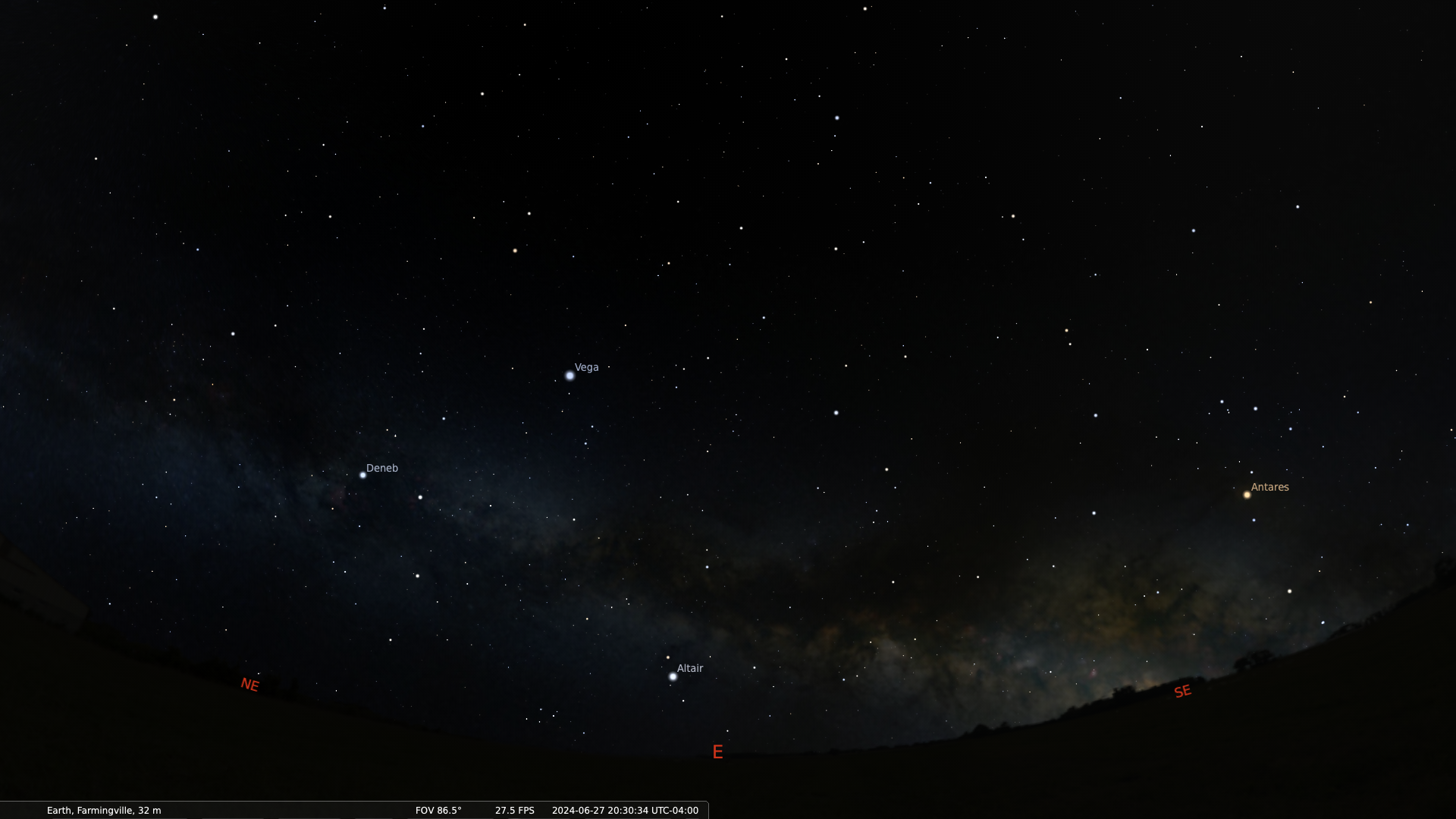
In this late June view to the east, we see the rising stars of summer with the summer triangle, the summer Milky Way, Antares to the west with the Milky Way’s galactic center.
Compared to other seasons, the summer sky is the richest with the most dense concentration of star clusters and star forming regions, a grand collection of celestial jewel boxes. On a clear, dark, moonless night, the summer night sky is a veritable feast for the eyes, from these celestial jewel boxes to the sprawling galactic center. Two of these clusters, both famous to observers in the Northern Hemisphere and visible now, concurrently during the same night, are the globular stars clusters Messier 3 and Messier 13.
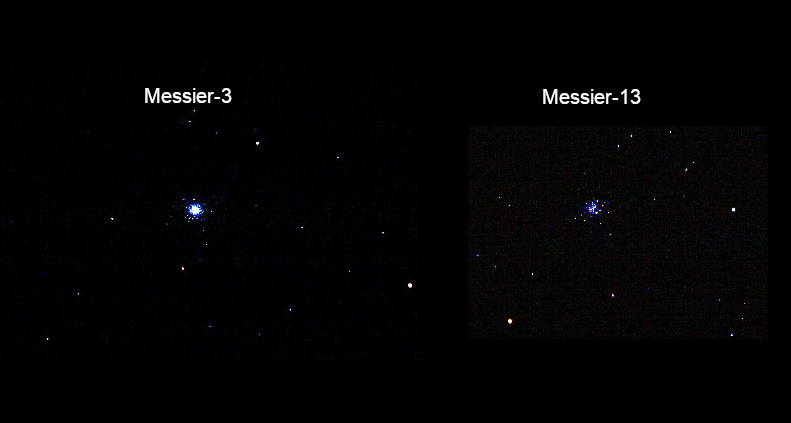
Messier-3 and Messier-13, both imaged by the author with his 20 cm (8″) F/7.2 astrograph. Both images digitized from the original Kodak Ektachrome slide. Original download size: 791×423. Full detailed description below.
Globular Star Clusters
Globular star clusters are vast and diverse agglomerations of 50,000 to 500,000 stars, all gravitational bound to each other, containing some of the oldest stars in the universe, some of them relics dating back to the cosmic dawn. These clusters technically reside outside the confines of the galaxy, in a region known as the “Galactic Halo”. In the case of Messier 3 and Messier 13 (M3 and M13), they are located north or “above” the galactic plane in the Milky Way’s galactic halo.
Messier 3
These clusters contain stars on four distinct evolutionary tracks: Main sequence stars (stars such as our sun), Red Giants (stars such as Arcturus), Asymptotic Branch and Horizontal Branch stars (the term “branch” refers to their evolutionary “track” on the Hertzsprung-Russell (HR) Diagram as illustrated below. Please refer to my study, highlighted below for more details.
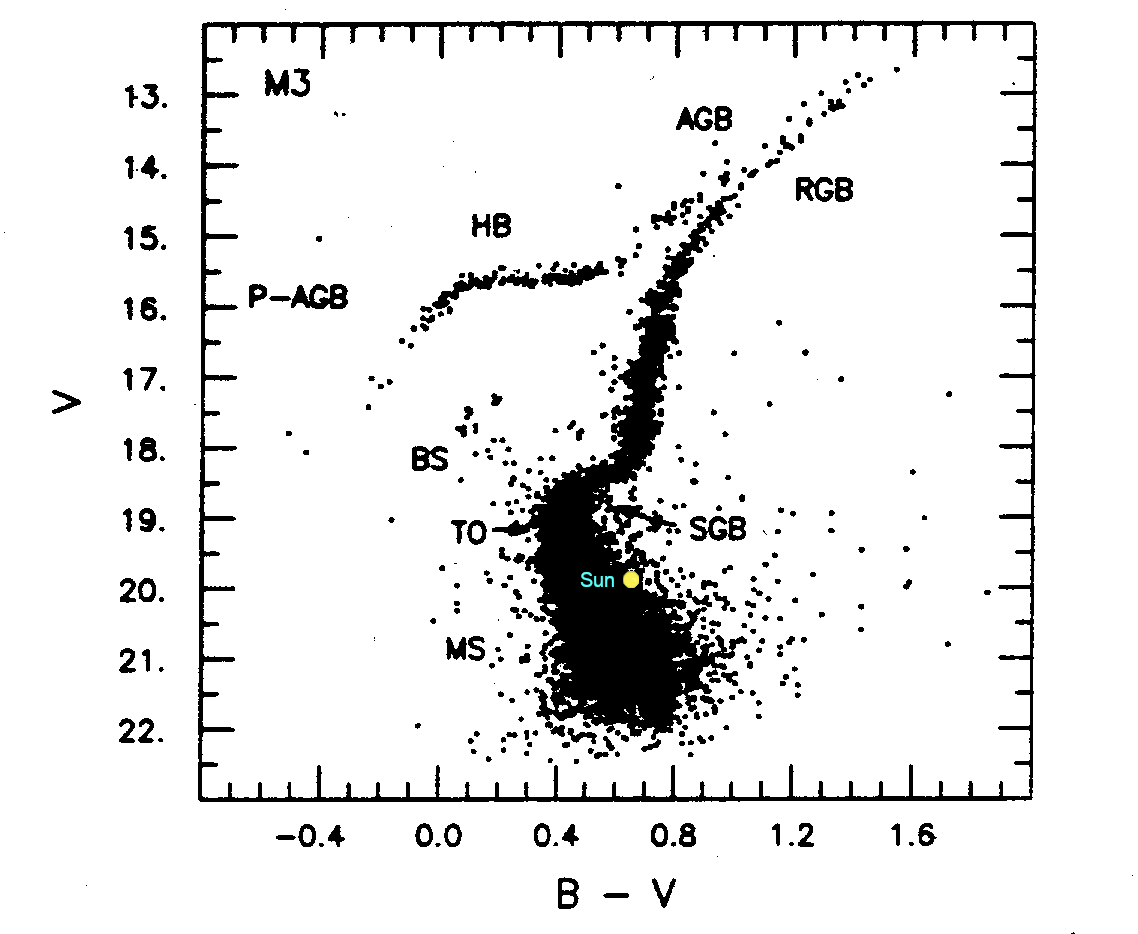
The annotated HR Diagram of the globular cluster Messier-3 showing the placement of the sun as a 20th magnitude object at the distance of Messier-3.
Messier 3 is a beautiful globular star cluster and the 3rd non-stellar object in Charles Messier’s famous catalog of non-stellar objects. It can be observed as a bright, fuzzy “patch” in a pair of 9×63 or 10×50 binoculars north and west of brilliant Arcturus in the constellation Canes Venatici, the “Hunting Dogs”, as illustrated in the video below.
It is a threshold naked-eye object with an apparent magnitude of 6.2 at 34,000 light years (10.4 KPc) distant. With a visual magnitude of 12.7 for the brightest cluster stars, evolved red giants and Asymptotic Giant Branch stars, a 15 cm (6”) telescope is necessary to resolve these stars and to begin to see the object’s true nature.
A video “zooming in” on the globular cluster M-3 in Canes Venatici. The video uses content from Stellarium and the author’s own images.
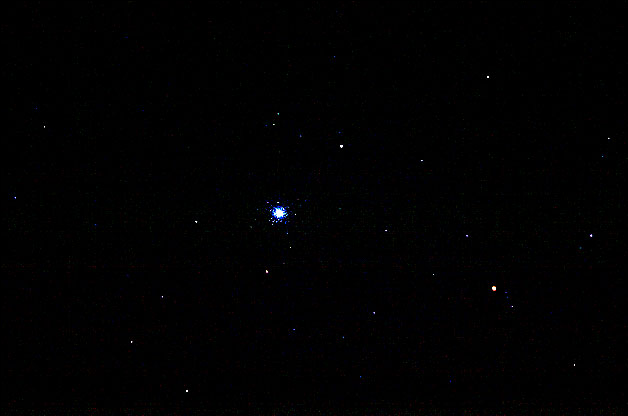
Messier 3 as imaged with the author’s 20 cm (8″) F/7.2 astrograph. Image acquisition details below. Original image download size: 628×416 px.
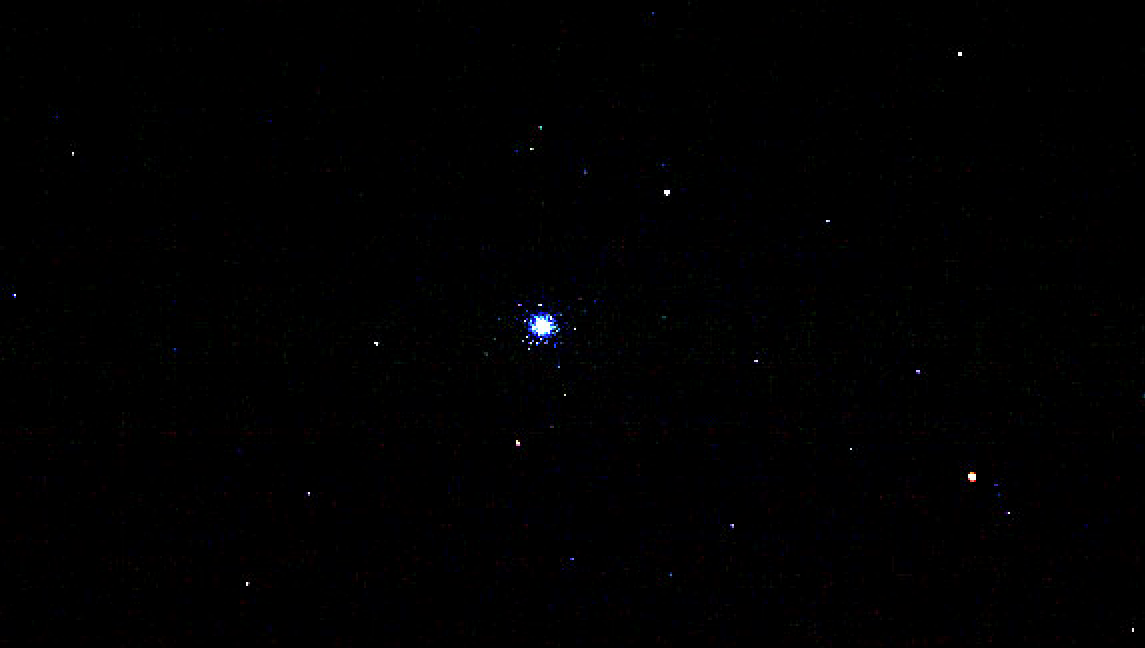
Messier 3 as imaged at prime focus with the author’s 20 cm (8″) F/7.2 astrograph (1440 mm focal length). Image acquisition details below. Original image download size: 1145×648 px.
Messier 3 imaged by the author in 1986 with a 20 cm (8″) F/7.2 Newtonian astrograph at “first” (Prime) focus. The cluster’s brightest stars have an apparent magnitude of 12.7 and are comparable to the brilliant red giant star Arcturus, located near the cluster on the sky. When you see these bright cluster stars, so small and distant, you’re looking at an Arcturus in each one of them, the same Arcturus that burns bright and friendly in our sky.
An Important Lesson
An important lesson in stellar luminosity can be learned here.
Globular clusters are relics, with stars that date back to early epochs on the cosmological time line. Arcturus, one of the five brightest stars in the sky and the principal star in Bootes the Herdsman (it looks more like a giant kite rather than a Herdsman), beckons red-orange, bright and friendly in our sky. It is a mere 37 light years distant. It is these stars, the evolved, red-giants, some of the stars that populate globular clusters, objects such as Messier-3, that allows us to see them at such staggering distances.
This telescope’s optics are diffraction limited and thus, the brightest cluster stars are resolved as tiny pinpoints with some of the cluster’s fainter, central stars visible at magnitude 15–16, overall resulting in approximately one pixel per star.
Equipment used
Telescope: 20 cm (8″) F/7.2 (1440 mm focal length) Newtonian astrograph at “first” (Prime) focus
Camera: Miranda Laborec modified to use a “knife edge” focus, with critical focus accomplished using a nearby bright star.
Film: Kodak High Speed Ektachrome 400 processed at ASA 400
Exposure: 15 minutes, manually guided using a Cave Observatory mounting, complete with a 33 cm (13”) “Beyers” Clock drive, Right Ascension and Declination fine motor controls and a 15 cm (6″) F/12 Newtonian guide scope.
Image digitized in August 2000 from the original 1986 Ektachrome slide.
Image scale: ~ 1 arc-second per pixel
Image resolution: ~1 arc second
It’s important to note that this short, 15-minute exposure captured only the central ‘core’ of the cluster, and that its full extent spans much of the space within the right triangle of stars enclosing the cluster.
Messier 13
A video “zooming in” on the great globular cluster M-13 in Hercules keystone. The video uses content from Stellarium and the author’s own images.
Messier 13 is much like Messier 3 but 11 KLy closer at 22,000 Ly. Current estimates put the number of stars between 300,000 and 500,000. The brightest star in the cluster is a red giant, the variable star V11, also known as V1554 Herculis, with an apparent visual magnitude of 11.95 and included in my study described below.
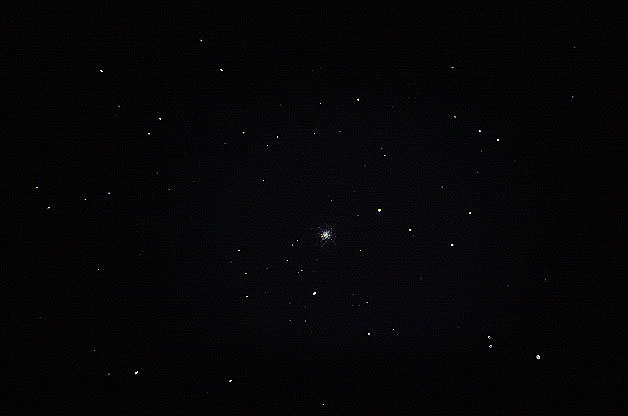
Messier 13 as imaged at prime focus with the author’s 15 cm (6″) F/4.2 astrograph (630 mm focal length). Note the tiny pinpoint star images, images that represent stars such as Arcturus. Image acquisition details below. Original image download size: 628×416 px.
Equipment used
Telescope: 15 cm (6″) F/4.2 Newtonian astrograph (630 mm focal length) at “first” (Prime) focus
Camera: Miranda Laborec modified to use a “knife edge” focus, with critical focus accomplished using a nearby bright star.
Film: Kodak High Speed Ektachrome 400 processed at ASA 400.
Exposure: 10 minutes, manually guided using a Cave Observatory mounting, complete with a 33 cm (13″) “Beyers” Clock drive, Right Ascension and Declination fine motor controls and a 15 cm (6″) F/12 Newtonian guidescope.
Image digitized in August 2000 from the original 1986 Ektachrome slide.
Image scale: ~ 1 arc-second per pixel
Image resolution: ~1 arc second
This telescope’s optics are diffraction limited and thus, the brightest cluster stars at magnitude 12 are resolved as tiny pinpoints. It is important to remember that these tiny points of light are stars such as Arcturus, a red giant star that burns bright and friendly in our own sky but at 22,000 Light years, appear as a tiny pinpoint of light.
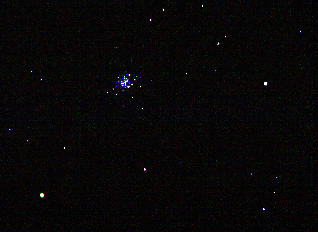
Messier 13 as imaged at prime focus with the author’s 20 cm (8″) F/7.2 astrograph (1440 mm focal length). Image acquisition details below. Original image download size: 443×323 px.
Equipment used
Telescope: 20 cm (8″) F/7.2 (1440 mm focal length) Newtonian astrograph at “first” (Prime) focus
Camera: Miranda Laborec modified to use a “knife edge” focus, with critical focus accomplished using a nearby bright star.
Film: Kodak High Speed Ektachrome 400 processed at ASA 400
Exposure: 10 minutes, manually guided using a Cave Observatory mounting, complete with a 33 cm (13″) “Beyers” Clock drive, Right Ascension and Declination fine motor controls and a 15 cm (6″) F/12 Newtonian guidescope.
Image digitized in August 2000 from the original 1986 Ektachrome slide.
Image scale: ~ 1 arc-second per pixel
Image resolution: ~1 arc second
It’s important to note that this short, 10-minute exposure captured only the central ‘core’ of the cluster, and that its full extent spans much more of the space between the two 7th magnitude stars on either side.
A Study
The author conducted a study of Messier-3 and Messier-13 using an Open-Source application known as “Source Extractor”. Using MS Excel, our images of Messier-3 and Messier-13 and the data produced from Source Extractor, we mapped the cluster stars of Messier-3 and Messier-13 reliably down to magnitude 16.5. As mentioned above, globular clusters contain four distinct stellar populations: Main Sequence stars, Red Giant Stars, Asymptotic Giant Branch stars and Horizontal Branch stars. A quick inspection of the chart above, identifies these 4 populations with the “Horizontal Branch” stars all predominantly at an apparent visual magnitude between 15 and 16 with most of them converging at ~15.5, well beyond the visual reach of anything smaller than a 1/2 meter (20″) diameter telescope. The following excerpt from our study of Messier-3 shows these stars were captured almost at the limit of detection for this short (15 minute) exposure.
Main Sequence Stars
Main sequence stars are stars in (1) Hydrostatic (gravitational) equilibrium and (2) produce energy through hydrogen fusion reactions in their cores. An example would be our home star, the Sun. The main sequence stars in Messier-3 and most globular clusters, as suggested by the chart above, have an absolute visual magnitude range between +7 with a visual magnitude of +22 (Red Dwarfs, M5V, 0.08 to 0.25 solar masses) through the sub-giant branch “turn off” at visual magnitude +18.5 for F8V to G0V stars with an absolute visual magnitude of +3.5. Why wouldn’t we find any brighter, more luminous main sequence stars in globular clusters and are these stars excluded from their stellar populations?
No, we wouldn’t find these stars represented as Main Sequence stars as they have aged beyond their productive, main sequence lifetime and have evolved. However, they are represented as evolved members of the cluster. Stars such as Sirius or Vega would NOT be found in these clusters.
With the brightest main sequence stars no brighter than visual magnitude +18.5 for Messier-3, no main sequence stars are represented in our study and would be at least 3 magnitudes fainter than the faintest star images recorded in this short, 15-minute exposure.
Red Giant Branch Stars
Red giant stars were main sequence stars that have depleted their compliment of core hydrogen, approximately 25% of their original mass. As the star evolves and becomes a stable red giant, it is in (1) Hydrostatic (gravitational) equilibrium and (2) will initially produce energy through helium fusion reactions in its cores through the Triple-Alpha process, a process that produces a Carbon-Oxygen inner core.
For stars up through 3 solar masses, this is the last nuclear burning cycle for the star, as it lacks the mass necessary for carbon ignition to occur at 100 M-Kelvin. As the star leaves the sub-giant phase and becomes a red giant, hydrogen shell burning has commenced “above” the fusing helium core. The bright red star Arcturus is an example of such a star. As discussed here, Arcturus is a 1 solar-mass star that has evolved off the main sequence with an age of 7.7 Gyr, 3.2 billion years older than the sun. It represents now what the sun will be like in 3.2 billion years! The sun, like Arcturus, will eventually become a planetary nebula, with a hot White-Dwarf remnant at it’s center eventually cooling off over billions of years.
Asymptotic Giant Branch Stars
These stars represent one of the last evolutoinary stages of evolution for stars between 0.5 and 8 solar masses. For solar mass stars, the expanding outer shell of the red giant, the original shell of gas that surrounded the energy-producing core during its main sequence phase, asymptotically exapands and dissipates to become a planetary nebula, hence the name, leaving behind a hot remnant of what was once its core at its center, a White Dwarf star, no longer producing energy.
Horizontal Branch Stars
Horizontal Branch stars are a specific phase in the evolution of stars, particularly those with masses similar to or slightly larger than the Sun. These stars are represented in my study and are illustrated in the graphic exerpt above as +15.5 magnitude objects, just above the limit of detection for the short, 15 minute exposure. In fact, most of the cluster’s HB stars are probably represented in the data.
Important points
1. Evolutionary Stages
– They represent an evolutonary phase in the post-main-sequence evolution of low- to intermediate-mass stars.
– The red giant phase, with the onset of helium burning, marks the beginning of the Horizontal Branch phase.
2. Core and Shell Burning
– Two sources of energy: classic Hydrogen shell-burning surrounding a fusing helium core.
3. Temperature and Luminosity
– Horizontal Branch stars have higher temperatures and luminosities compared to their previous red giant phase.
– Their temperatures range from about 5,000 K to 30,000 K, and can be quite luminous, often between 50 to 100 Solar luminosities! As an example, considering the placement of the sun in the chart above and the prevailing magnitude of +15.5 for the M-3’s HB stars, they are 20 – 15.5 = 4.5 magnitudes brighter or 63 solar luminosities (2.512^4.5)!
4. Color and Placement on the H-R Diagram
– On the Hertzsprung-Russell (H-R) diagram, Horizontal Branch stars form a nearly horizontal line, hence the name.
– They are typically found in globular clusters, where they form a distinct horizontal band across the H-R diagram.
– Depending on their temperature, they can appear blue, white, or yellow.
5. Types of HB Stars
– Red Horizontal Branch (RHB): Cooler HB stars appear red or yellow.
– Blue Horizontal Branch (BHB): Hotter HB stars appear blue or white.
– Extreme Horizontal Branch (EHB): Very hot HB stars that can have temperatures exceeding 20,000 K.
The Importance of Horizontal Branch Stars
1. Standard Candles
– Since their their luminosities are relatively well known, Horizontal Branch stars, particularly the RR Lyrae variable stars, are used as standard candles to measure astronomical distances
2. Stellar Populations
– The distribution and properties of HB stars in a globular cluster can provide important information about the age, chemical composition, and evolution of the cluster.
3. Chemical Composition
– The study of these stars helps our understanding the chemical evolution of galaxies. The presence of certain elements in these stars give us clues and insights regarding the nucleosynthetic processes in earlier generations of stars.




